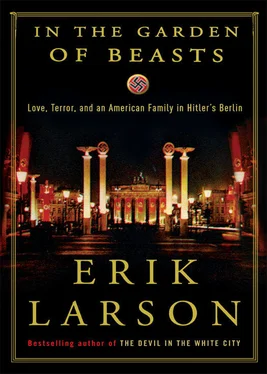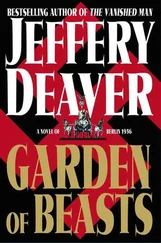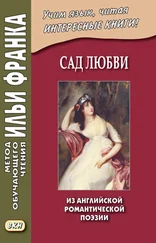A central element of Coordination was the insertion into Germany’s civil service law of the “Aryan clause,” which effectively banned Jews from government jobs. Additional regulations and local animosities severely restricted Jews from practicing medicine and becoming lawyers. As onerous and dramatic as these restrictions were for Jews, they made little impression on tourists and other casual observers, partly because so few Jews lived in Germany. As of January 1933 only about 1 percent of Germany’s sixty-five million people were Jewish, and most lived in major cities, leaving a negligible presence throughout the rest of the country. Nearly a third—just over 160,000—lived in Berlin alone, but they constituted less than 4 percent of the city’s overall population of 4.2 million, and many lived in close-knit neighborhoods not typically included on visitors’ itineraries.
Yet even many Jewish residents failed to grasp the true meaning of what was occurring. Fifty thousand did see, and left Germany within weeks of Hitler’s ascension to chancellor, but most stayed. “Hardly anyone thought that the threats against the Jews were meant seriously,” wrote Carl Zuckmayer, a Jewish writer. “Even many Jews considered the savage anti-Semitic rantings of the Nazis merely a propaganda device, a line the Nazis would drop as soon as they won governmental power and were entrusted with public responsibilities.” Although a song popular among Storm Troopers bore the title “When Jewish Blood Spurts from My Knife,” by the time of the Dodds’ arrival violence against Jews had begun to wane. Incidents were sporadic, isolated. “It was easy to be reassured,” wrote historian John Dippel in a study of why many Jews decided to stay in Germany. “On the surface, much of daily life remained as it had been before Hitler came to power. Nazi attacks on the Jews were like summer thunderstorms that came and went quickly, leaving an eerie calm.”
The most visible marker of the Coordination campaign was the sudden appearance of the Hitler salute, or Hitlergruss . It was sufficiently new to the outside world that Consul General Messersmith devoted an entire dispatch to the subject, dated August 8, 1933. The salute, he wrote, had no modern precedent, save for the more narrowly required salute of soldiers in the presence of superior officers. What made the practice unique was that everyone was expected to salute, even in the most mundane of encounters. Shopkeepers saluted customers. Children were required to salute their teachers several times a day. At the close of theatrical performances, a newly established custom demanded that audiences stand and salute as they sang first the German national anthem, “Deutschland über Alles,” and second the Storm Trooper anthem, the “Horst Wessel Lied,” or “Horst Wessel Song,” named for its composer, an SA thug killed by communists but whom Nazi propaganda subsequently transformed into a hero. The German public had so avidly embraced the salute as to make the act of incessantly saluting almost comical, especially in the corridors of public buildings where everyone from the lowliest messenger to the loftiest official saluted and Heil ed one another, turning a walk to the men’s room into an exhausting affair.
Messersmith refused to salute and merely stood at attention, but he understood that for ordinary Germans that would not have sufficed. At times even he felt real pressure to conform. At the close of a luncheon he attended in the port city of Kiel, all the guests stood and with right arms extended sang the national anthem and the “Horst Wessel Song.” Messersmith stood respectfully, as he would have in America for the “Star-Spangled Banner.” Many of the other guests, including a number of Storm Troopers, glared at him and whispered among themselves as if trying to divine his identity. “I felt really quite fortunate that the incident took place within doors and among on the whole intelligent people,” he wrote, “for if it had been in a street gathering or in an outdoor demonstration, no questions would have been asked as to who I was, and that I would have been mishandled is almost unquestionable.” Messersmith recommended that American visitors try to anticipate when the songs and salute would be required and leave early.
He did not think it funny when now and then Ambassador Dodd threw him a mock salute.
DURING HER SECOND WEEK in Berlin, Martha discovered that she had not shed her past as completely as she had hoped.
Bassett, her husband, arrived in the city on what he privately called his “Mission to Berlin,” hoping to win Martha back.
He checked in at the Hotel Adlon. They saw each other several times, but Bassett did not get the tear-filled rapprochement he had hoped for. Rather, he found a cordial indifference. “You remember our bicycle ride through the park,” he wrote later. “You were friendly, but I sensed a difference between us.”
To make matters worse, toward the end of his stay Bassett caught a severe cold. It laid him flat, just in time for Martha’s last visit before his departure.
He knew that his Mission to Berlin had failed the moment Martha arrived in his room. She had brought her brother, Bill.
It was a moment of casual cruelty. She knew Bassett would interpret it correctly. She was tired. She had loved him once, but their relationship had been too fraught with misunderstandings and conflicting imperatives. Where there had been love, as Martha later put it, there were now only “embers,” and these were not enough.
Bassett understood. “You had had it,” he wrote. “And who could blame you!”
He sent her flowers, acknowledging defeat. The card that accompanied them began, “To my charming and lovely ex-wife.”
He left for America, for Larchmont, New York, and a suburban life of lawn mowing and tending the copper beech in his backyard and evening drinks and potlucks and a train commute to his job at the bank. He wrote later, “I’m not at all sure you would have been happy as the wife of a bank economist, preoccupied with the Bank Letter, bringing up a family of children, PTA, and all that.”
MARTHA’S CONNECTION WITH Sigrid Schultz soon began to pay off. Schultz threw a welcome party for Martha on July 23, 1933, and invited a number of her closest friends, among them still another correspondent, Quentin Reynolds, who wrote for the Hearst News Service. Martha and Reynolds hit it off instantly. He was big and cheerful, with curly hair and eyes that always seemed to convey a sense of impending laughter—though he had a reputation, as well, for being hard-nosed, skeptical, and smart.
They met again five days later in the bar at the Esplanade, along with her brother, Bill. Like Schultz, Reynolds knew everyone and had managed to befriend a number of Nazi officials, including a confidant of Hitler with the tongue-twisting name Ernst Franz Sedgwick Hanfstaengl. A Harvard graduate with an American-born mother, Hanfstaengl was known to play piano for Hitler late at night to soothe the dictator’s nerves. No Mozart or Bach. Mostly Wagner and Verdi, Liszt and Grieg, some Strauss and Chopin.
Martha wanted to meet him; Reynolds knew of a party to be thrown by a fellow correspondent where Hanfstaengl was expected to be a guest and offered to bring her along.
CHAPTER 7
Hidden Conflict
Dodd walked from the Esplanade to his office each morning, a fifteen-minute stroll along Tiergartenstrasse, the street that formed the southern boundary of the park. On the south side stood mansions with lush grounds and wrought-iron fences, many belonging to embassies and consulates; on the north sprawled the park itself, dense with trees and statuary, its paths inked with morning shade. Dodd called it “the most beautiful park I have ever seen,” and the walk quickly became his favorite part of the day. His office was in the embassy chancery on a street just off the park called Bendlerstrasse, which also contained the “Bendler Block,” a collection of squat, pale, rectangular buildings that served as the headquarters of the regular German army, the Reichswehr.
Читать дальше












